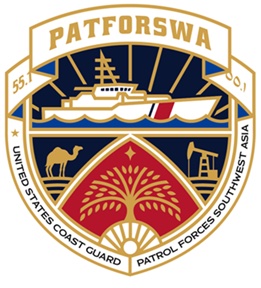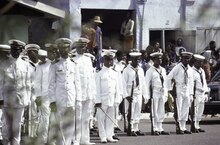
The Armed Forces of Liberia (AFL) are the armed forces of the Republic of Liberia. Tracing its origins to a militia that was formed by the first black colonists in what is now Liberia, it was founded as the Liberian Frontier Force in 1908, and retitled in 1956. For almost all of its history, the AFL has received considerable materiel and training assistance from the United States. For most of the 1941–89 period, training was largely provided by U.S. advisers, though this assistance has not prevented the same generally low levels of effectiveness common to most of the armed forces in the developing world.

The United States Coast Guard (USCG) is the maritime security, search and rescue, and law enforcement service branch of the United States Armed Forces and one of the country's eight uniformed services. The service is a maritime, military, multi-mission service unique among the United States military branches for having a maritime law enforcement mission with jurisdiction in both domestic and international waters and a federal regulatory agency mission as part of its duties. It is the largest coast guard in the world, rivaling the capabilities and size of most navies.

The Posse Comitatus Act is a United States federal law signed on June 18, 1878, by President Rutherford B. Hayes which limits the powers of the federal government in the use of federal military personnel to enforce domestic policies within the United States. Congress passed the Act as an amendment to an army appropriation bill following the end of Reconstruction and updated it in 1956, 1981 and 2021.

A coast guard or coastguard is a maritime security organization of a particular country. The term embraces wide range of responsibilities in different countries, from being a heavily armed military force with customs and security duties to being a volunteer organization tasked with search and rescue without law enforcement authority. In most countries, a typical coast guard's functions are distinct from those of the navy and the transit police, while in certain countries they have similarities to both.

The United States Coast Guard Reserve is the reserve component of the United States Coast Guard. It is organized, trained, administered, and supplied under the direction of the Commandant of the Coast Guard through the Assistant Commandant for Reserve (CG-R).

U.S. Coast Guard Port Security Units are Deployable Specialized Forces organized for sustained expeditionary security and anti-terrorism. They provide Anti-Terrorism Force Protection (ATFP) missions, which include harbor and port defense, protection of High Value Assets (HVAs), expeditionary security, Sea Lines of Communications (SLOCs), special missions. and coastal surveillance. PSUs are expeditionary units that conduct OCONUS missions in support of a requesting regional combatant commander. PSUs usually operate under the direction of the Coast Guard's Pacific Area (PACAREA) command but are unique in that they are the only Coast Guard units that can be quickly requested by the Department of Defense.

The Defender-class boat, also called Response Boat–Small (RB-S) and Response Boat–Homeland Security (RB-HS), is a standard boat introduced by the United States Coast Guard in 2002. The boats serve a variety of missions, including search and rescue, port security and law enforcement duties and replaces a variety of smaller non-standard boats.

Law Enforcement Detachments or LEDETs are specialized, deployable maritime law enforcement teams of the United States Coast Guard. First established in 1982, their primary mission is to deploy aboard U.S. and allied naval vessels to conduct counter-drug operations and support maritime law enforcement, interdiction, or security operations. LEDETs are the operational elements of the Coast Guard’s two Tactical Law Enforcement Teams (TACLETs) which are part of the Coast Guard’s Deployable Specialized Forces (DSF). As of April 2010 there are seventeen LEDETs.
The history of the United States Coast Guard goes back to the United States Revenue Cutter Service, which was founded on 4 August 1790 as part of the Department of the Treasury. The Revenue Cutter Service and the United States Life-Saving Service were merged to become the Coast Guard per 14 U.S.C. § 1 which states: "The Coast Guard as established January 28, 1915, shall be a military service and a branch of the armed forces of the United States at all times." In 1939 the United States Lighthouse Service was merged into the Coast Guard. The Coast Guard itself was moved to the Department of Transportation in 1967, and on 1 March 2003 it became part of the Department of Homeland Security. However, under 14 U.S.C. § 3 as amended by section 211 of the Coast Guard and Maritime Transportation Act of 2006, upon the declaration of war and when Congress so directs in the declaration, or when the President directs, the Coast Guard operates as a service in the Department of the Navy.
The United States Coast Guard is the coastal defense, search and rescue, and maritime law enforcement branch of the United States Armed Forces and is one of the country's eight uniformed services. It carries out three basic roles, which are further subdivided into eleven statutory missions. The three roles are:

Visit, board, search, and seizure (VBSS) is the term used by United States military and law enforcement agencies for maritime boarding actions and tactics. VBSS teams are designed to capture enemy vessels, combat terrorism, piracy, and smuggling, and to conduct customs, safety and other inspections.

The Special Missions Training Center (SMTC), also known as Joint Maritime Training Center (JMTC), is a joint United States Coast Guard, Navy, and Marine Corps training facility located on Camp Lejeune, North Carolina. SMTC's mission is to provide relevant and credible Maritime Security Training and Operational Testing and Evaluation in support of Department of Defense and Department of Homeland Security missions. SMTC comprises four main divisions: Weapons, Port Security, Engineering / Logistics, and Fast Boat.

United States Naval Districts is a system created by the United States Navy to organize military facilities, numbered sequentially by geographic region, for the operational and administrative control of naval bases and shore commands in the United States and around the world. Established in 1903, naval districts became the foundational system for organizing U.S. naval forces ashore during the 20th century. The term "Naval" forces includes United States Marine Corps and current United States Coast Guard units.

The Georgian Coast Guard is the maritime arm of the Georgian Border Police, within the Ministry for Internal Affairs of Georgia. It is responsible for the maritime protection of the entire 310 km (190 mi) Black Sea coastline of Georgia, as well as the Georgian territorial waters. The northern half of this coastaline is since the 2008 South Ossetia war under the control of Abkhazia, though. The primary missions of the service are administration of the territorial waters, marine pollution protection, maritime law enforcement, search and rescue, port security and maritime defence.

The US employs divers in several branches of the armed forces, including the navy, army, marines, air force and coast guard.

China Coast Guard (CCG) is the maritime security, search and rescue, and law enforcement service branch of the People's Armed Police of China.

The Deployable Specialized Forces (DSF) —formerly Deployable Operations Group— are part of the United States Coast Guard that provide highly equipped, trained and organized deployable specialized forces, to the Coast Guard, United States Department of Homeland Security (DHS), United States Department of Defense (DoD) and inter-agency operational and tactical commanders. The command was formerly headquartered in Arlington, Virginia where it was established on 20 July 2007, and was commanded by a captain. It was decommissioned by the Commandant of the Coast Guard, Admiral Robert Papp on 1 October 2013, with units previously assigned to the DOG being split between Coast Guard Pacific and Atlantic Area commands. The units were subsequently reorganized under Deployable Specialized Forces (DSF).

Patrol Forces Southwest Asia (PATFORSWA) is a United States Coast Guard command based in Manama, Bahrain. PATFORSWA was created in November 2002 as a contingency operation to support the U.S. Navy with patrol boats. The command's mission is to train, equip, deploy, and support combat-ready Coast Guard forces conducting operations in support of Operation Iraqi Freedom (OIF), Operation Enduring Freedom (OEF), Operation Inherent Resolve (OIR) in the Naval Forces Central Command's area of responsibility. It was commissioned as a permanent duty station in June 2004. In July 2003, PATFORSWA moved from its own compound to facilities at Naval Support Activity Bahrain.
The history of the United States Coast Guard Auxiliary began in 1939. From its formation, the United States Coast Guard Auxiliary has been supporting the United States Coast Guard. The Auxiliary works within the Coast Guard in carrying out its noncombatant and non-law enforcement missions.

























